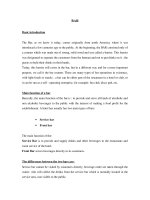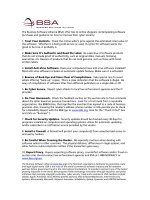Tài liệu Communication pdf
Bạn đang xem bản rút gọn của tài liệu. Xem và tải ngay bản đầy đủ của tài liệu tại đây (1.44 MB, 12 trang )
communication
Best ways to interact with
the person with dementia
®
A-Communications.indd 1A-Communications.indd 1 9/21/05 2:34:18 AM9/21/05 2:34:18 AM
2
Alzheimer’s disease and related
dementias can gradually diminish
a person’s ability to communicate.
Not only do people with dementia
have more difficulty expressing
thoughts and emotions, they also have
more trouble understanding others.
The ability to exchange our ideas,
wishes and feelings is a basic need.
Communication is:
• Sending and receiving messages
• How we relate to each other
• An important part of our relationships
• A way to express who we are
• More than talking and listening
• About attitude, tone of voice, facial expressions
and body language
A-Communications.indd 2A-Communications.indd 2 9/21/05 2:34:22 AM9/21/05 2:34:22 AM
3
Changes in communication
Changes in the ability to communicate are
unique to each person. A caregiver may
recognize differences in the person with
dementia such as:
• Difficulty finding the right words
• Using familiar words repeatedly
• Inventing new words to describe familiar things
• Easily losing train of thought
• Difficulty organizing words logically
• Reverting to speaking in a native language
• Using curse words
• Speaking less often
• More often relying on gestures instead
of speaking
A number of physical conditions and
medications can also affect a person’s
ability to communicate. Consult your doctor
when you notice major changes.
The Alzheimer’s Association recommends
ways to communicate with the person with
dementia so you might understand each
other better. Inside, you’ll find tips for:
1 Helping the person communicate page 4
2 Best ways for you to communicate page 6
3 People with hearing limitations page 10
4 People with vision limitations page 11
A-Communications.indd 3A-Communications.indd 3 9/21/05 2:34:23 AM9/21/05 2:34:23 AM
4
1 Helping the person communicate
Communicating with a person with dementia
requires patience and understanding. Above all,
you must be a good listener.
To help the person communicate:
Be patient and supportive
Let the person know you’re listening and trying to
understand what is being said.
Show your interest
Keep good eye contact. Show the person that you
care about what is being said.
Offer comfort and reassurance
If he or she is having trouble communicating,
let the person know that it’s OK. Encourage the
person to continue to explain his or her thoughts.
Give the person time
Let the person think about and describe whatever
he or she wants to. Be careful not to interrupt.
Avoid criticizing or correcting
Don’t tell the person what he or she is saying
is incorrect. Instead, listen and try to find the
meaning in what is being said. Repeat what was
said, if it helps to clarify the thought.
Avoid arguing
If the person says something you don’t agree with,
let it be. Arguing usually only makes things worse.
Offer a guess
If the person uses the wrong word or cannot find
a word, try guessing the right one. If you under-
stand what the person means, you may not need
to give the correct word. Be careful not to cause
unnecessary frustration.
A-Communications.indd 4A-Communications.indd 4 9/21/05 2:34:24 AM9/21/05 2:34:24 AM
5
Encourage unspoken communication
If you don’t understand what is being said, ask the
person to point or gesture.
Limit distractions
Find a place that’s quiet, so you won’t be inter-
rupted. The surroundings should support the
person’s ability to focus on his or her thoughts.
Focus on the feelings, not the facts
Sometimes the emotions being expressed are
more important than what is being said. Look for
the feelings behind the words. At times, tone of
voice and other actions may provide clues.
A-Communications.indd 5A-Communications.indd 5 9/21/05 2:34:24 AM9/21/05 2:34:24 AM









